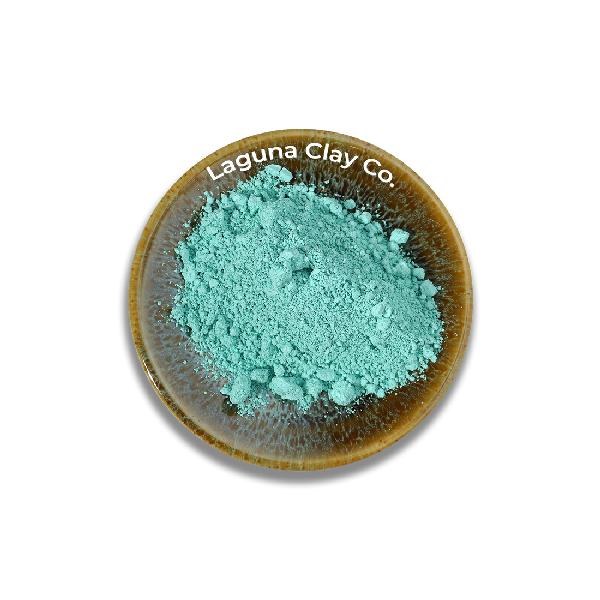Copper Carbonate (50# Bag)
| Qty: | Unit Price per LB: |
|---|---|
| 5 | $27.74 |
| 10 | $24.66 |
| 50 | $18.50 |
| 100 | $15.41 |
Item#: 79474921
MPN: MCOPCARB
Alternate Names: Synthetic Malachite, CuCO3
- Full bag is 50 lbs
* A green powder used as a glaze colorant.
- May produce green, blue-green or copper red depending on conditions and formulation.
This form of copper carbonate is the article of commerce. What you are getting when you buy it is a mixture of theoretical copper carbonate and copper hydroxide. The chemical structure sees two Cu atoms bonding to an OH each and sharing a CO3. Data sheets might quote the amount of Cu metal in the material (rather than CuCO3 or Cu(OH)2).
Copper Carbonate has a fairly complex decomposition. The accompanying curve shows the history of weight loss as this material is fired (courtesy of Bob Hickerson, World Metal, LLC). It is interesting to compare this chart with the one for Copper Hydroxide to see the difference in the amount of weight lost, and when and how fast it occurs.
As with other metallic coloring carbonates, copper carbonate is bulkier than the oxide form, thus it tends to disperse better to give more even results. It is also more reactive chemically and thus melts better. As such, it is ideal for use in brushwork where minimal speck is required. However, it produces gases as it decomposes and these can cause pinholes, orange peeling and blisters in glazes. Also, the carbonate form contains less copper per gram, therefore colors are less intense than the oxide form.
The hydroxyl component is an important aid in dispersing the powder throughout the glaze slurry and thus avoid specks in the fired glaze.
Supplies of green copper carbonate basic often vary in color and density (darker and heavier, lighter and fluffier) reflecting variations in raw materials and manufacturing procedures. Despite variations in the physical appearance of the material, the amount of contained copper metal remains essentially constant.
The raw powder begins to melt between 1950 and 2000F. At around 1500F it gases and will discolor nearby items in the kiln.


Share:
Share on Facebook Share on Twitter Share on Pinterest Tell a friend